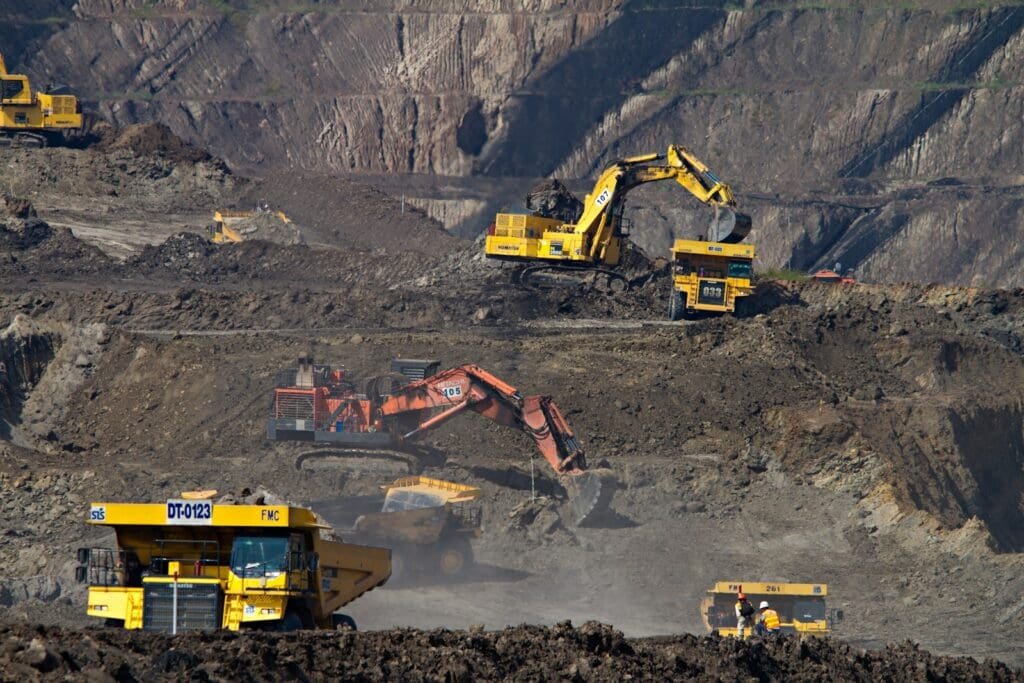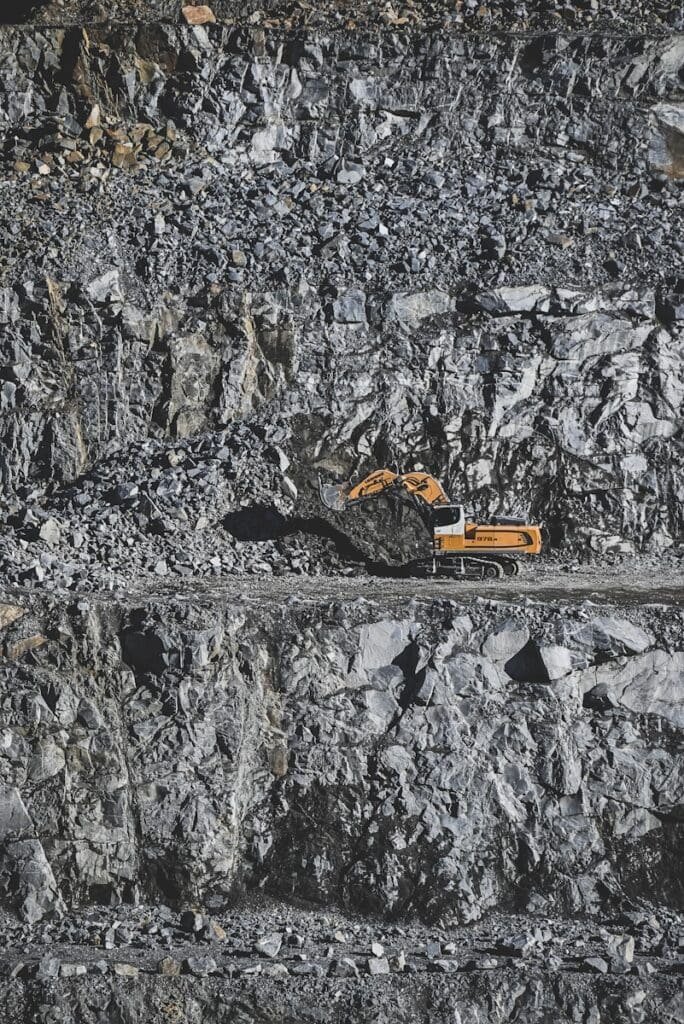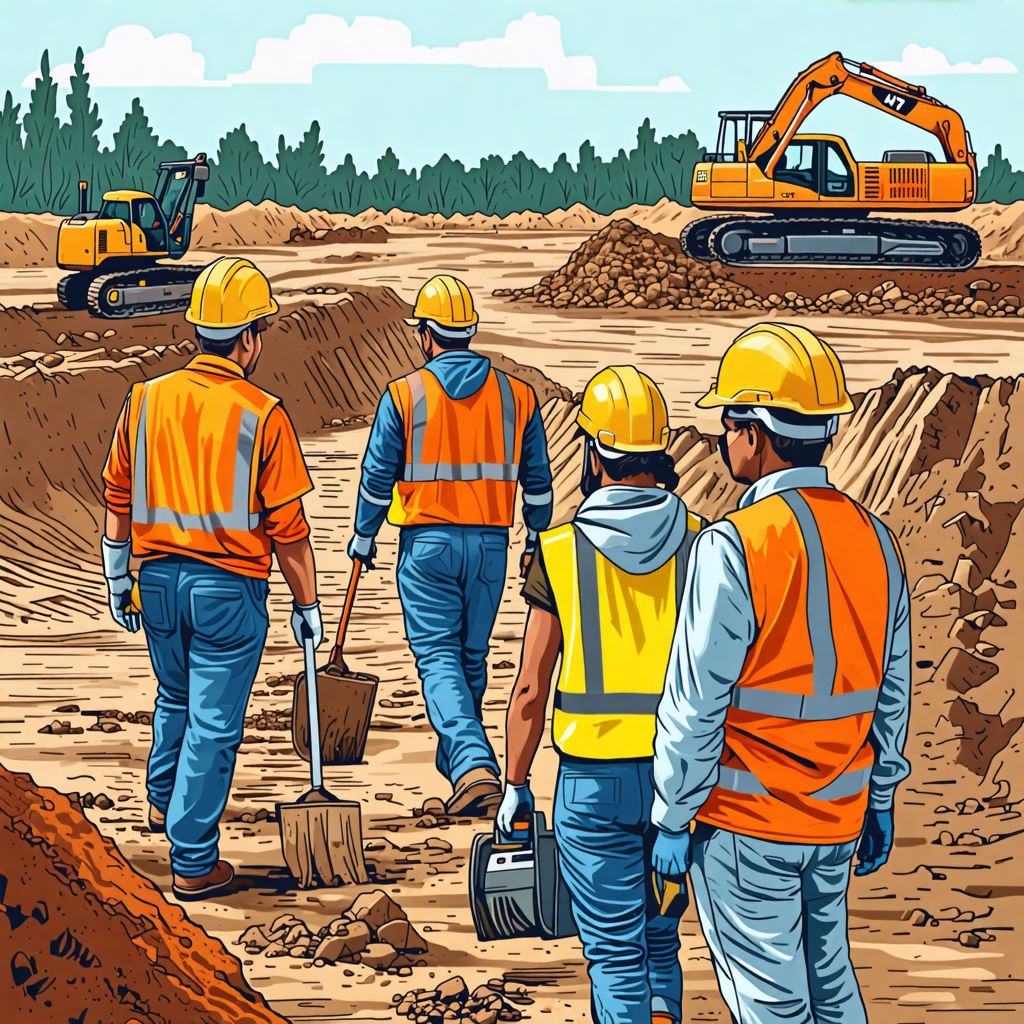Introduction To OSHA Excavation Safety
Did you know that each year, numerous excavation-related incidents claim lives and cause severe injuries?
This worrying trend makes it essential for us to understand and comply with OSHA’s regulations for excavation safety. In this article, we’ll explore the key OSHA regulations, additional safety practices, the 5 4 3 2 1 excavation rule, and types of excavation protection.
Our aim? To keep you and your work site safe and compliant.
So, let’s get started!
Table of Contents
OSHA Regulations for Excavation Safety

Introduction to OSHA Regulations
Excavation work is essential in construction projects but can be hazardous. The Occupational Safety and Health Administration (OSHA) sets forth regulations to ensure the safety of workers performing excavation tasks.
Key OSHA Regulations
OSHA’s regulations for excavation safety focus on preventing hazards such as cave-ins, falls, and equipment-related accidents. The key regulations include:
- Protective Systems
- Surface Encroachments
- Exposure to Falling Loads
- Appropriate Training
Protective Systems
OSHA mandates the use of protective systems to prevent cave-ins:
- Sloping: This involves cutting back the trench wall at an angle inclined away from the excavation.
- Shoring: Using supports such as timber or metal hydraulic systems to prevent soil movement.
- Shielding: Utilizing trench boxes or other supports to protect workers from collapsing soil.
Surface Encroachments
Materials, equipment, and spoil piles should be kept at least 2 feet from the edge of excavations to prevent falls and cave-ins.
Exposure to Falling Loads
Workers must be kept away from loads being lifted or lowered into the excavation. Equipment operators need to be extra careful when maneuvering loads.
Appropriate Training
All workers involved in excavations must receive adequate training. Topics should cover recognizing hazards, understanding protective systems, and knowing emergency procedures.
Data Table: OSHA Excavation Safety Requirements
| Requirement | Description |
|---|---|
| Protective Systems | Sloping, shoring, and shielding methods to prevent soil collapse. |
| Surface Encroachments | Maintain at least 2 feet distance from the edge of the excavation. |
| Falling Loads | Keep workers clear of loads being lifted or lowered into the excavation. |
| Training | Provide comprehensive training to recognize and avoid hazards. |
Conclusion
Ensuring compliance with OSHA regulations is vital for excavation safety in construction. It protects workers from the many risks present in such environments. For more comprehensive details on OSHA’s requirements, refer directly to the OSHA official website.
Additional Safety Practices in Excavation Work

Frequent Inspections
In addition to implementing protective systems, surface encroachments, and training programs for excavation work, frequent inspections are a necessary safety protocol. These should occur daily, with additional checks following any event that could increase the likelihood of a cave-in, such as a heavy rainstorm. Inspections should always be performed by a competent individual.
Daily Inspections
Daily or regular inspections can help detect potential hazards in real time. This proactive step ensures that any found risks are mitigated before any incidents occur. Inspectors should assess the stability of the excavation, the effectiveness of the protective system, and whether any heavy equipment is posing a risk to workers.
Event-Based Inspections
In the event of a significant change in the work site conditions, such as a rainfall or a seismic activity, a further inspection is necessary. It’s important to ensure that events have not altered the stability of the site or the integrity of the protective systems.
Emergency Response Planning
An emergency response plan should be in place. Similar to the requirement for all workplaces to have a fire evacuation plan, an excavation worksite should have an equivalent plan for emergencies such as a cave-in or flooding.
Establishing Evacuation Routes and Safety Zones
The plan should clearly outline evacuation routes and safety zones. Having a plan allows for a quick and efficient response in the event of an emergency, mitigating potential injuries and fatalities.
Training on Emergency Procedures
All workers should receive instruction on what to do in the case of an emergency. This includes understanding the alarm system, what to do in the case of a cave-in, how to secure the area safely, and knowing the location of the nearest first aid kit.
Data Table: Additional Safety Practices in Excavation
| Safety Practice | Description |
|---|---|
| Frequent Inspections | Daily checks and event-based inspection to confirm ongoing safety. |
| Emergency Response Planning | Creation of a detailed evacuation and response plan for incidents. |
| Establishing Evacuation Routes and Safety Zones | Clear definition of safe zones and paths for escape during emergencies. |
| Training on Emergency Procedures | Ensure workers are well-informed on emergency response and first-aid procedures. |
Importance of Continuous Safety Monitoring
Continuous monitoring plays a vital role in ensuring safety in excavation works. Monitoring allows for immediate identification and rectification of potential hazards — including cave-ins, falls, or equipment-related accidents. Comprehensive safety practices — from routine checks to detailed emergency response planning — help provide a safer working environment. For further information, OSHA’s Best Practices in Excavation provide a comprehensive guide.
What is the 5 4 3 2 1 Excavation Rule?
Introduction to the 5 4 3 2 1 Excavation Rule
The “5 4 3 2 1” excavation rule is a set of best practices designed to enhance safety during excavation activities. Though not explicitly an OSHA regulation, this rule provides a structured approach to reduce risks and maintain compliance with safety standards.
Components of the 5 4 3 2 1 Rule
This rule breaks down into five specific steps that workers and supervisors should follow:
- 5 Feet
- 4 Steps
- 3 Elements
- 2 Checks
- 1 Goal
5 Feet
Ensure there’s a 5-foot clearance from the edge of the excavation for all personnel and equipment not involved in immediate digging operations. This distance helps prevent accidental falls and improves safety.
4 Steps
Follow these four critical steps during excavation preparation:
- Planning: Develop a detailed plan, including identifying potential hazards and designing protective systems like trenches or shoring.
- Training: Educate workers on safety procedures and proper use of equipment to minimize risks.
- Executing: Perform the excavation work according to the plan, ensuring all safety measures are in place.
- Monitoring: Continuously monitor the excavation site for hazards and compliance with safety procedures.
3 Elements
Emphasize three main elements that are vital for excavation safety:
- Soil Type: Identify the type of soil being excavated to determine appropriate protective measures. Cohesive soils, for example, have different stability compared to granular soils.
- Protective Systems: Implement systems like benching, sloping, trench boxes, and shoring to protect workers.
- Surface Encroachments: Keep materials, equipment, and spoil piles at least 2 feet away from the edge of the trench.
2 Checks
Conduct two essential checks to ensure continued safety:
- Daily Inspections: Inspect the excavation site daily, focusing on protective systems, soil stability, and equipment safety.
- Event-Based Inspections: Perform additional inspections after significant events like heavy rains or seismic activity that could impact excavation stability.
1 Goal
The ultimate goal is to achieve a zero-incident excavation site. This objective is realized through thorough planning, diligent execution, continuous monitoring, and rapid response to any hazards.
Practical Takeaways from the 5 4 3 2 1 Rule
Following the 5 4 3 2 1 rule ensures a systematic approach to excavation safety, encompassing planning, training, protection, and inspections. This not only complies with OSHA regulations but also cultivates a culture of safety that minimizes accidents and hazards.
Three Types of Excavation Protection
Introduction to Excavation Protection
Excavation work is integral to many construction projects, but it comes with significant risks, such as cave-ins, equipment accidents, and exposure to hazardous materials. Effective excavation protection strategies are vital to ensure the safety of all workers involved. OSHA emphasizes three primary types of protective systems to mitigate these dangers: sloping, shoring, and shielding.
Types of Excavation Protection
Understanding and implementing these protective systems is crucial for any construction site to maintain safety standards and prevent accidents.
Sloping
Sloping involves cutting back the trench walls at an angle inclined away from the excavation to prevent soil from collapsing into the trench.
– Method: The slope angle depends on the soil type, with steeper angles for more stable soils.
– Application: Best used in wide-open areas where space allows for sloped walls without interfering with structures or utilities.
– Advantages: Simple to implement and requires no additional materials.
– Limitations: Requires a large area; not suitable for confined spaces.
Shoring
Shoring uses supports, such as timber or metal hydraulic systems, to prevent the excavation walls from collapsing.
– Method: Vertical or horizontal braces are installed to stabilize the trench walls.
– Application: Ideal for deeper excavations and locations where space is limited.
– Advantages: Provides strong support for trench walls and can be adapted to various trench configurations.
– Limitations: Requires additional equipment and setup time; ongoing maintenance might be needed.
Shielding
Shielding involves using trench boxes or other support structures to protect workers within the trench.
– Method: Pre-constructed boxes or shields are placed inside the trench to safeguard workers from soil collapse.
– Application: Suitable for areas where sloping and shoring are impractical.
– Advantages: Quick installation with minimal disruption, highly effective protection for workers.
– Limitations: Limited by the size of the trench box; regular inspection to ensure integrity.
Data Table: Comparison of Excavation Protective Systems
| Protective System | Method | Application | Advantages | Limitations |
|---|---|---|---|---|
| Sloping | Cutting back trench walls at an angle | Open areas with ample space | Simple, no additional materials | Requires large area, not for confined spaces |
| Shoring | Supports to prevent wall collapse | Deep excavations and tight spaces | Strong support, adaptable configuration | Equipment needed, maintenance required |
| Shielding | Trench boxes for worker protection | Areas where sloping/shoring not feasible | Quick installation, effective protection | Limited by trench box size, regular inspection needed |
Implementing Protective Systems
Choosing the appropriate protective system depends on factors such as soil type, trench depth, excavation width, and available space:
– Soil Type: Assess the stability of the soil. More cohesive soils allow for steeper slopes, while granular soils might require shoring or shielding.
– Trench Depth & Width: Deeper and wider trenches often necessitate more robust support structures, favoring shoring or shielding.
– Space Availability: Limited space might not permit sloping, making shoring or shielding more practical options.
In conclusion: Fostering a Safer Excavation Work Environment
The safety of workers involved in excavation tasks relies heavily on understanding and continuously adhering to established guidelines and best practices.
This includes implementing OSHA’s regulations together with the 5 4 3 2 1 rule and incorporating the three protective systems – sloping, shoring and shielding, as appropriate. Routinely conducted inspections, comprehensive training, and preparation for emergency scenarios are also vital components of a safe excavation work environment.
For a more thorough understanding, readers are encouraged to refer to OSHA’s official and excavation best practices guides.
Frequently Asked Questions – FAQs
What are the key OSHA regulations for excavation work?
OSHA regulations chiefly focus on four key areas: the use of protective systems, handling of surface encroachments, prevention against exposure to falling loads, and proper training of involved personnel.
What is the 5 4 3 2 1 rule in excavation?
The 5-4-3-2-1 rule stands for 5 feet clearance, 4 steps of excavation preparation, 3 major elements for safety, performing 2 types of checks, and 1 ultimate goal – zero incidents on site.
What are the three types of excavation protection?
The three primary types of excavation protection are sloping, shoring and shielding. All three have their pros and cons and their application depends on multiple factors such as soil type, and available space.






